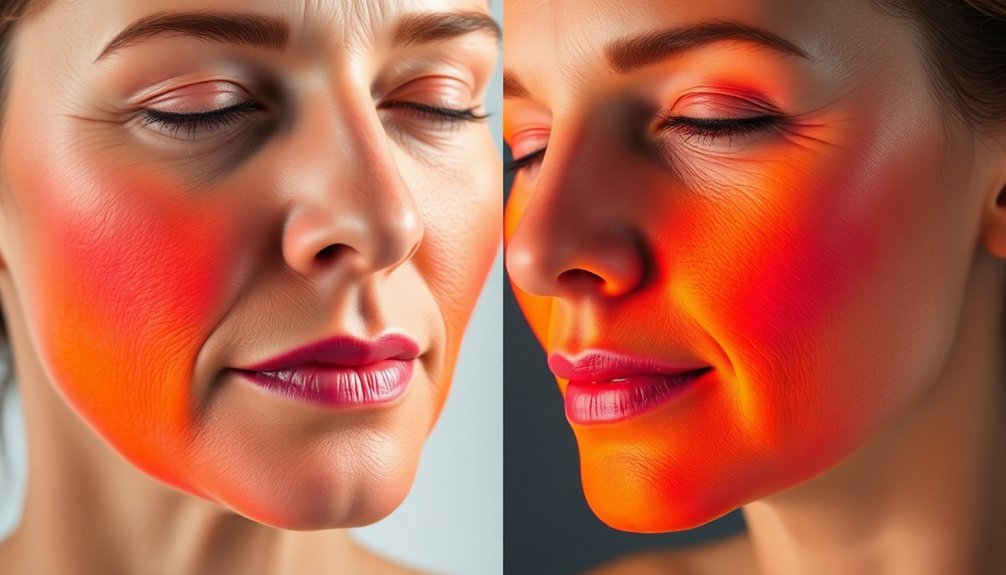Thermal energy face lifts offer you a proven non-surgical solution for facial rejuvenation, with an impressive 97.8% of patients reporting significant improvements. You'll experience immediate skin tightening as radiofrequency or plasma energy penetrates deep layers, stimulating natural collagen production. The treatment targets multiple areas including laugh lines, jawline, and neck with minimal downtime – you can return to normal activities right away. While results last 1-2 years and cost $1,000-$5,000 per session, they're considerably more affordable than traditional facelifts. Today's advanced monitoring systems and personalized treatment plans make this technology more effective than ever before.
Understanding Thermal Energy Face Lifts

Three key components make thermal energy face lifts an innovative cosmetic treatment: radiofrequency energy, collagen stimulation, and non-invasive application.
When you undergo this procedure, radiofrequency energy penetrates your skin's layers, simultaneously heating both the dermis and subcutaneous tissue. This targeted heating triggers an immediate tightening effect as your existing collagen fibers contract. Most patients experience mild redness afterward that typically fades within hours.
You'll experience both immediate and long-term benefits from the treatment. The heat energy activates your skin's fibroblasts, which produce new collagen and elastin fibers, leading to sustained improvements in your skin's firmness and elasticity.
You can target multiple areas, including laugh lines, jawline, chin, and neck, making it a versatile solution for facial rejuvenation.
What makes thermal energy face lifts particularly appealing is their non-surgical nature. You won't need to worry about lengthy recovery periods or invasive procedures. Instead, you'll receive treatment from technologies like fractional radio-frequency, Exilis, Thermage, or Thermi systems.
These proven methods effectively address mild to moderate signs of aging while maintaining your skin's natural appearance and requiring minimal downtime.
Scientific Benefits Behind HIFU Technology
While thermal energy face lifts offer significant benefits, High-Intensity Focused Ultrasound (HIFU) technology represents another major advancement in non-surgical facial rejuvenation.
HIFU's mechanism of action penetrates deeper into your skin layers than many other treatments, effectively stimulating collagen production through a process called neocollagenesis. Patient anatomy and experience greatly influence treatment success.
What makes HIFU particularly impressive is its precision and FDA-approved status for improving lines and wrinkles on your face, neck, and chest. You're getting results that were previously only possible through surgery, but without incisions or recovery time.
Clinical evidence supports these claims, with studies showing that 66% of patients noticed visible improvements in their facial appearance after just 90 days.
You'll appreciate that HIFU offers more sustainable outcomes compared to laser treatments, thanks to its ability to target foundational skin layers. While it works best if you have mild-to-moderate skin laxity, you won't need to worry about scarring or extended recovery periods.
The treatment's ongoing developments in precision and combination therapies continue to enhance its effectiveness, making it an increasingly popular choice for non-surgical facial rejuvenation.
Patient Results and Success Metrics
Non-surgical thermal energy face lifts will show initial results within one to three months, with continued improvements as your skin's collagen production increases over time.
You'll notice markedly less downtime compared to surgical procedures, as most patients return to normal activities immediately after treatment, experiencing only minor redness or swelling that resolves within 24 hours.
While surgical facelifts may offer more dramatic changes, thermal treatments like Thermage and Fotona 4D provide consistent success rates with results lasting 12-24 months, making them an effective option for those seeking natural-looking facial rejuvenation. The treatment uses radiofrequency technology to stimulate collagen production while keeping the skin's surface protected with a cooling effect.
Immediate Post-Treatment Changes
Success stories from thermal energy face lifts consistently demonstrate both immediate and long-term benefits for patients seeking skin rejuvenation. You'll notice visible improvements right after treatment, though the most dramatic results develop over time. The treatment works by using radiofrequency energy to stimulate collagen production beneath the skin's surface.
| Treatment Type | Immediate vs. Long-term Results |
|---|---|
| Ultherapy | Initial firmness; peak results at 3-6 months |
| ThermiSmooth Face | Immediate smoothing; continues improving for 3-6 months |
| Thermage | Instant tightening; ideal results at 3-6 months |
| Duration | Results last 1-2 years per session |
| Side Effects | Temporary redness, swelling, or tingling possible |
When you choose thermal energy treatments, you'll experience gradual improvements in skin tightening and lifting. The results appear natural, with patients reporting high satisfaction rates. Your skin will feel firmer and look smoother immediately after treatment, though you might notice some temporary redness or swelling. These minor side effects typically resolve quickly, and you'll continue seeing improvements for several months. For ideal results, it's essential to choose a qualified practitioner and maintain realistic expectations about your treatment timeline. The investment pays off, as results from a single session can last up to two years.
Recovery vs. Surgical Options
Understanding your options between thermal energy treatments and surgical facelifts can help you make an informed decision about recovery expectations and results.
With thermal treatments like ThermiTight and Thermage, you'll experience minimal downtime, typically returning to normal activities within 24-48 hours. These procedures offer gradual improvements that continue developing over several months.
Ultherapy, which uses ultrasound technology, allows immediate return to daily activities with only mild, temporary side effects like redness or swelling.
In contrast, surgical facelifts require several weeks to months of recovery time, though they provide the longest-lasting results of 5-10 years.
You'll notice that non-surgical options deliver natural-looking results through collagen stimulation. ThermiTight's effects continue improving for up to a year, while Thermage results can last 1-2 years. Ultherapy shows noticeable improvements within 2-3 months, lasting up to a year.
While surgical facelifts offer more dramatic and enduring results, thermal energy treatments provide significant improvements with substantially less recovery time, making them an attractive option if you're seeking effective results without extended downtime.
Long-Term Success Rates
While recovery timelines provide valuable insight into treatment choices, long-term results tell an even more compelling story. Both Thermage and Ultherapy demonstrate impressive success rates, with patients experiencing visible improvements that can last up to two years after a single treatment.
You'll typically notice the full effects within 3-6 months post-procedure, and these results continue to improve over time with proper skin maintenance.
The data shows remarkable patient satisfaction levels, particularly in facial treatments. You can expect:
- 97.8% of patients report "very good" or better improvements after one year
- Results peak at 3-4 months for Ultherapy treatments
- Visible lifting effects last 1-2 years with a single session
- Success rates remain high even after 12.6 years, with 68.5% of patients still rating improvements as "very good"
These non-surgical options excel in different areas: Thermage works particularly well for men with thicker skin and those with oily complexions, while Ultherapy shows exceptional results for sagging jowls and brows.
When combined with annual maintenance programs, you can maintain these rejuvenating effects for years to come.
Comparing Surgical Vs Thermal Options
Choosing between surgical and thermal facelift options comes down to your goals and expectations for facial rejuvenation. If you're seeking dramatic, long-lasting results, particularly for moderate to severe signs of aging, surgical facelifts provide up to 10 years of rejuvenation and can make you look approximately 11 years younger. However, you'll need to commit to 1-2 weeks of recovery time.
For mild to moderate aging concerns, thermal energy treatments like Ultraformer, Thermage, or Renuvion offer less invasive alternatives. While you won't experience the same dramatic results as surgery, you'll benefit from minimal downtime and can return to your activities immediately.
| Aspect | Surgical Facelift | Thermal Energy Treatment |
|---|---|---|
| Longevity | 5-10+ years | Few months to 2 years |
| Recovery Time | 1-2 weeks | Minimal to none |
| Results | Dramatic, extensive | Subtle, gradual |
| Best For | Moderate to severe aging | Mild to moderate aging |
Consider your age, skin condition, and lifestyle when making your choice. Surgical options provide more extensive rejuvenation but require significant recovery time, while thermal treatments offer subtle improvements with minimal interruption to your daily routine.
Cost Analysis and Treatment Value

Beyond considering the treatment approach, the financial investment of facial rejuvenation plays a key role in decision-making. You'll find thermal energy treatments like Thermage ranging from $1,000 to $5,000, making them considerably more affordable than traditional surgical options. While thermal treatments offer a lower entry point, they'll need to be repeated every 1-3 years to maintain results.
When evaluating your options, consider these cost-value factors:
- Traditional facelifts ($10,000-$20,000) provide the longest-lasting results, often extending up to 10 years.
- Mid-face lifts ($6,000-$12,000) offer targeted improvements at a moderate price point.
- Mini facelifts ($3,500-$8,000) present an economical surgical option for mild aging.
- Thermal treatments avoid facility fees and anesthesia costs, reducing your total investment.
Your geographical location and provider expertise will influence final costs. If you're younger with mild aging concerns, you might find better value in thermal treatments or thread lifts.
However, if you're seeking dramatic, long-term results, the higher initial investment of surgical options could prove more cost-effective over time, despite their steeper upfront costs.
Recovery Time and Patient Comfort
You'll appreciate how thermal energy face lifts let you return to work within 3-4 days of treatment, making them an excellent option for busy professionals.
You won't experience significant pain during or after the procedure, as local anesthesia and minimal discomfort make the recovery process remarkably manageable.
Your daily activities can resume quickly, with most swelling subsiding within the first week and only light activity restrictions for two weeks post-treatment.
Quick Return to Work
Thermal energy face lifts offer remarkably quick recovery periods compared to traditional surgical procedures. You'll notice that treatments like FaceTite allow you to return to work within 3-4 days, while traditional facelifts can require up to two weeks of dedicated downtime.
This rapid recovery makes thermal treatments particularly appealing for busy professionals who can't afford extended absences.
During your recovery, you'll experience minimal bruising and swelling, which typically subsides within the first week. While you'll need to avoid strenuous physical activity for two weeks, you can resume most daily activities relatively quickly. The results continue to improve over time, with ideal outcomes visible up to 9 months post-procedure.
Here's what you can expect during your recovery timeline:
- Days 1-3: Initial swelling and minimal bruising
- Days 3-4: Return to work and normal daily activities
- Day 7: Most residual edema subsides
- Week 2: Cleared for all physical activities
If you're considering a facial rejuvenation procedure, thermal energy treatments offer a practical solution that won't substantially disrupt your work schedule or daily routine.
Pain-Free Treatment Experience
Along with rapid recovery times, one of the most appealing aspects of thermal energy face lifts is their virtually pain-free nature. You'll experience initial improvements within 6-8 weeks, with results continuing to enhance for up to 9 months. While there's some swelling due to local anesthetic fluid injection, it typically subsides within 3-4 days, with any remaining puffiness resolving within a week.
| Recovery Milestone | Thermal Energy Lift | Traditional Facelift |
|---|---|---|
| Return to Activities | Almost immediate | 2 weeks minimum |
| Swelling Duration | 3-4 days | 4-6 weeks |
| Physical Exercise | Resume after 2 weeks | Resume after 6-12 months |
Unlike traditional facelifts, you won't need long incisions or stitches, minimizing the risk of scarring. The procedure's comfort level means you can resume your daily routine almost immediately, though you'll need to avoid strenuous physical activity for two weeks. Local anesthesia guarantees you're comfortable throughout the treatment, and any minimal bruising that occurs is rare. Remember to maintain proper skincare afterward, including high-SPF sunscreen, to optimize and extend your results.
Zero Downtime Benefits
One of the most attractive features of thermal energy face lifts is their true "zero downtime" nature, allowing patients to return to their daily routines immediately after treatment. Unlike traditional surgical facelifts that require weeks of recovery, you won't need to take time off work or adjust your social calendar.
There's no need for post-operative protocols, hospital stays, or special restrictions on your activities.
Your comfort and convenience are prioritized with these non-invasive treatments, which typically take less than an hour to complete. You'll appreciate these key benefits:
- No surgical incisions or scarring, eliminating the need for lengthy healing periods
- Immediate return to normal activities, including work, exercise, and social events
- No anesthesia required, reducing both risks and recovery complications
- Cost-effective treatment when considering the absence of downtime and minimal risk factors
The treatment's versatility makes it suitable for all skin types, and you'll find it's well-tolerated with minimal discomfort. While results develop gradually, you're gaining long-term benefits without sacrificing weeks of your life to recovery, making it an ideal option for busy professionals seeking facial rejuvenation.
Latest Advances in Energy Treatments

Recent breakthroughs in energy-based treatments have revolutionized the cosmetic industry, particularly in facial rejuvenation procedures. You'll find that new non-invasive thermal devices now offer unprecedented precision in targeting specific skin layers while minimizing damage to surrounding tissues. These innovations integrate AI and machine learning to customize treatments based on your unique skin characteristics and desired outcomes.
Real-time monitoring systems have transformed how practitioners deliver thermal energy, allowing them to adjust treatment parameters instantly for ideal results. You'll benefit from advanced wearable sensors that continuously measure your skin's thermo-physical properties during treatment, ensuring both safety and effectiveness.
| Innovation | Benefit | Impact |
|---|---|---|
| AI Integration | Personalized Treatment Plans | Better Outcomes |
| Real-time Monitoring | Precise Energy Delivery | Enhanced Safety |
| Wearable Sensors | Continuous Assessment | Ideal Results |
| IoMT Technology | Remote Monitoring | Improved Follow-up |
| Smart Algorithms | Pattern Recognition | Predictable Results |
These technological advances haven't just improved treatment accuracy; they've also reduced recovery time and minimized complications. You'll experience better results with less downtime, thanks to sophisticated thermal delivery systems that protect your skin while stimulating natural collagen production and tissue remodeling.
Frequently Asked Questions
Can HIFU Treatments Be Combined With Other Cosmetic Procedures?
Yes, you can safely combine HIFU with various treatments like microneedling, chemical peels, and dermal fillers. You'll achieve better results when you pair HIFU with complementary procedures, but always consult a qualified professional first.
What Skin Conditions Might Disqualify Someone From Getting HIFU Treatment?
You won't qualify for HIFU if you have active skin infections, cystic acne, open lesions, severe skin laxity, photodamaged skin, or metal implants in the treatment area. Recent surgery's also a disqualifier.
How Many HIFU Sessions Are Typically Needed for Optimal Results?
You'll typically need 1-3 HIFU sessions for best results, though this varies based on your age, skin condition, and treatment area. Your provider will create a customized plan based on your specific needs.
Does Hair Growth Interfere With HIFU Treatment Effectiveness?
No, your hair growth doesn't interfere with HIFU treatment effectiveness. HIFU targets deep skin layers while bypassing the surface, so it can work effectively regardless of hair growth in the treatment area.
Are There Specific Skincare Products Recommended Before and After HIFU Treatment?
Before HIFU, you'll need gentle cleansers and hydrating moisturizers. After treatment, use soothing serums, zinc oxide sunscreen, and hyaluronic acid products. Wait three days before reintroducing active ingredients like retinol or vitamin C.
In Summary
You'll find thermal energy face lifts offer a compelling alternative to traditional surgery, balancing effectiveness with convenience. As you weigh your options, consider how HIFU technology delivers measurable results without lengthy downtimes or invasive procedures. While costs may initially seem high, you're investing in a proven treatment that's continually evolving with technological advances. Your path to facial rejuvenation doesn't have to include a scalpel anymore.





Leave a Reply